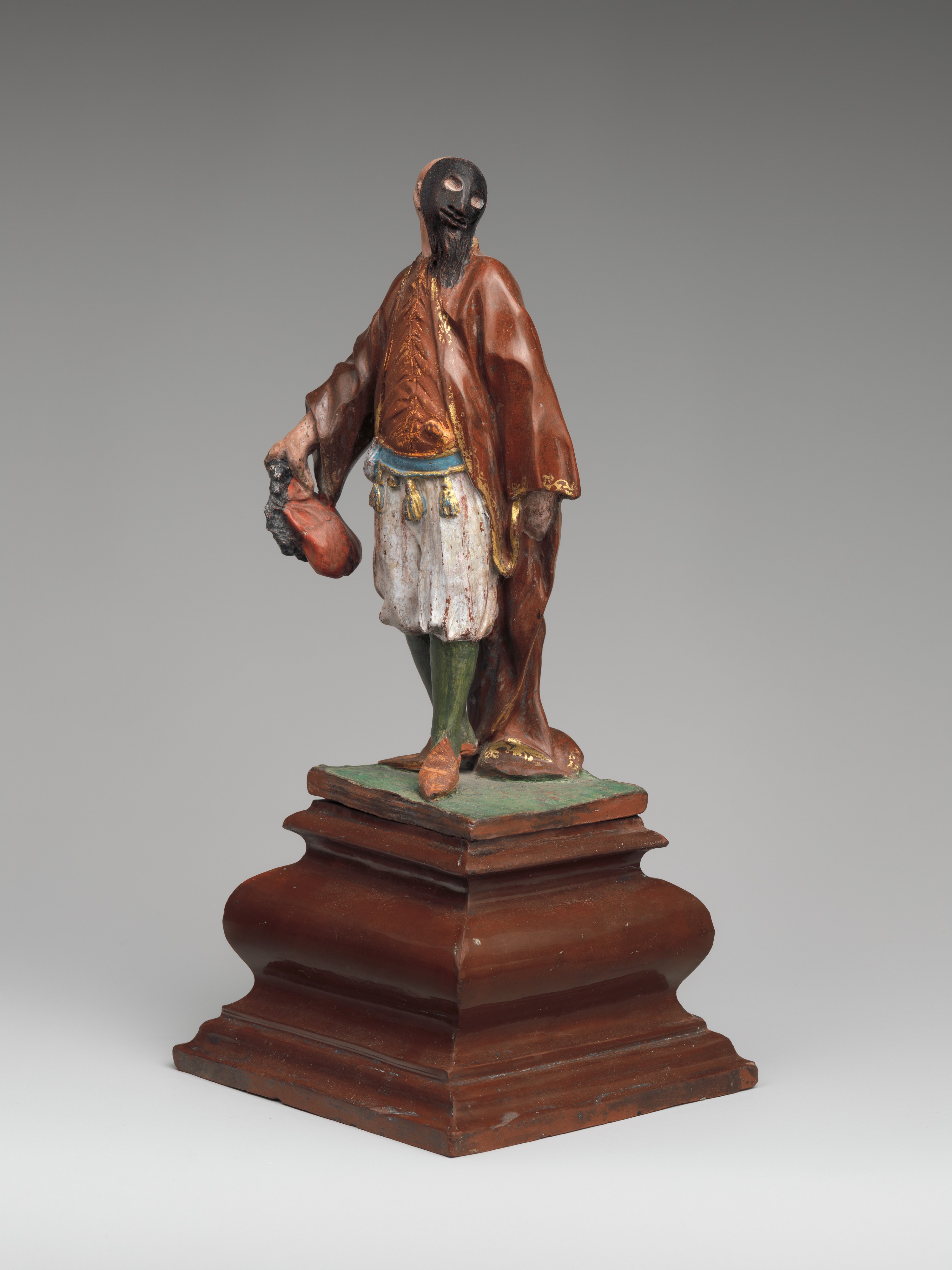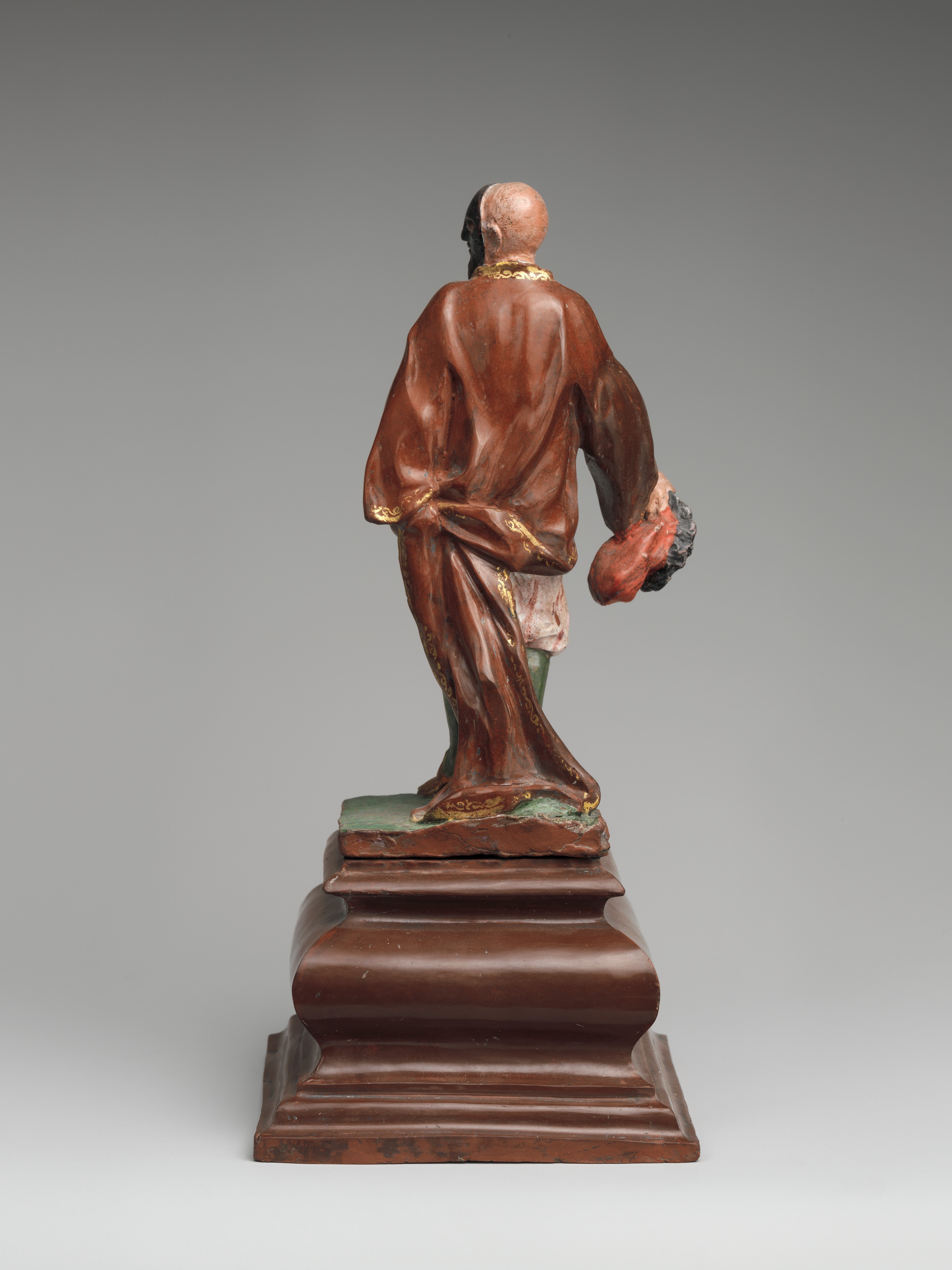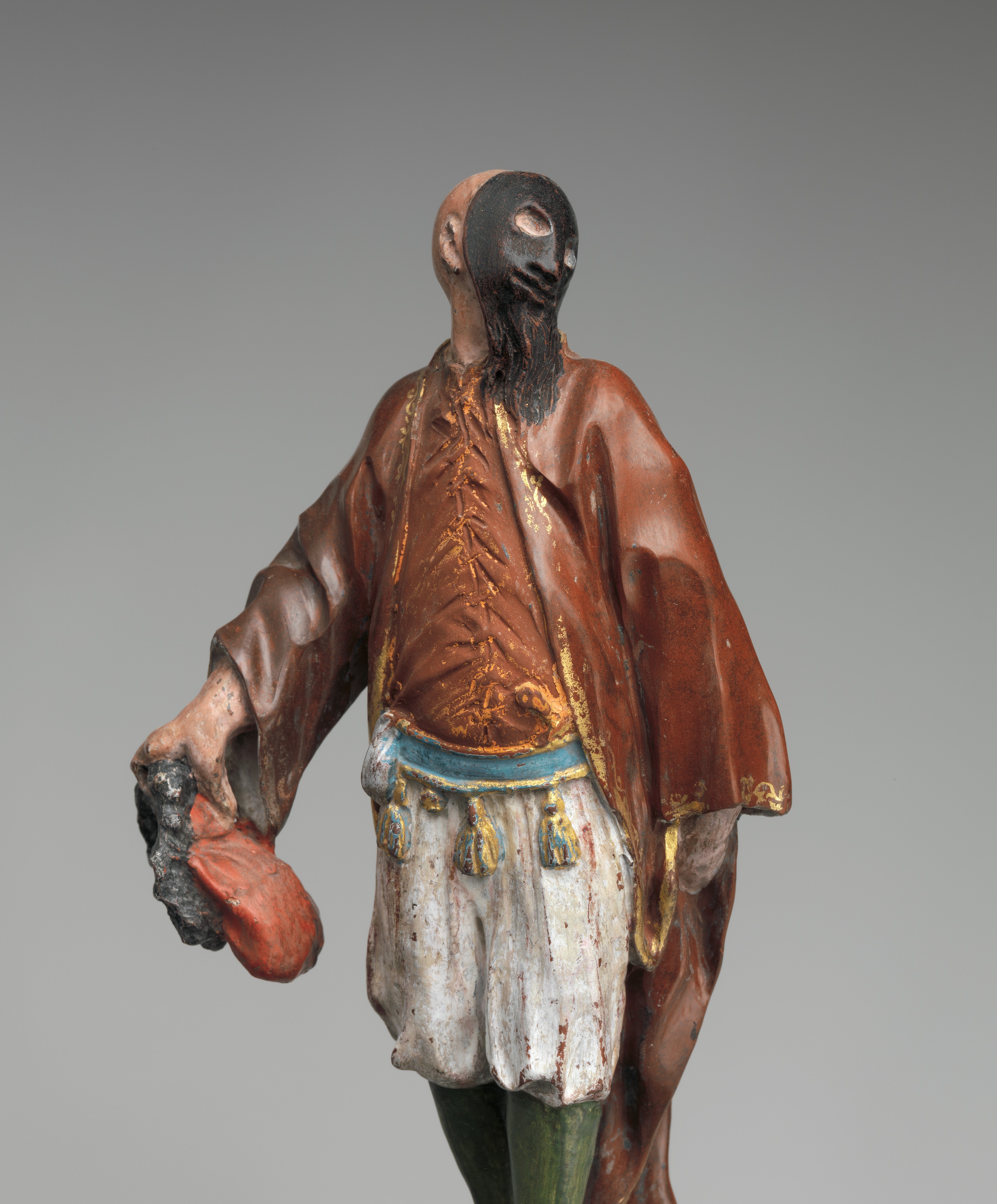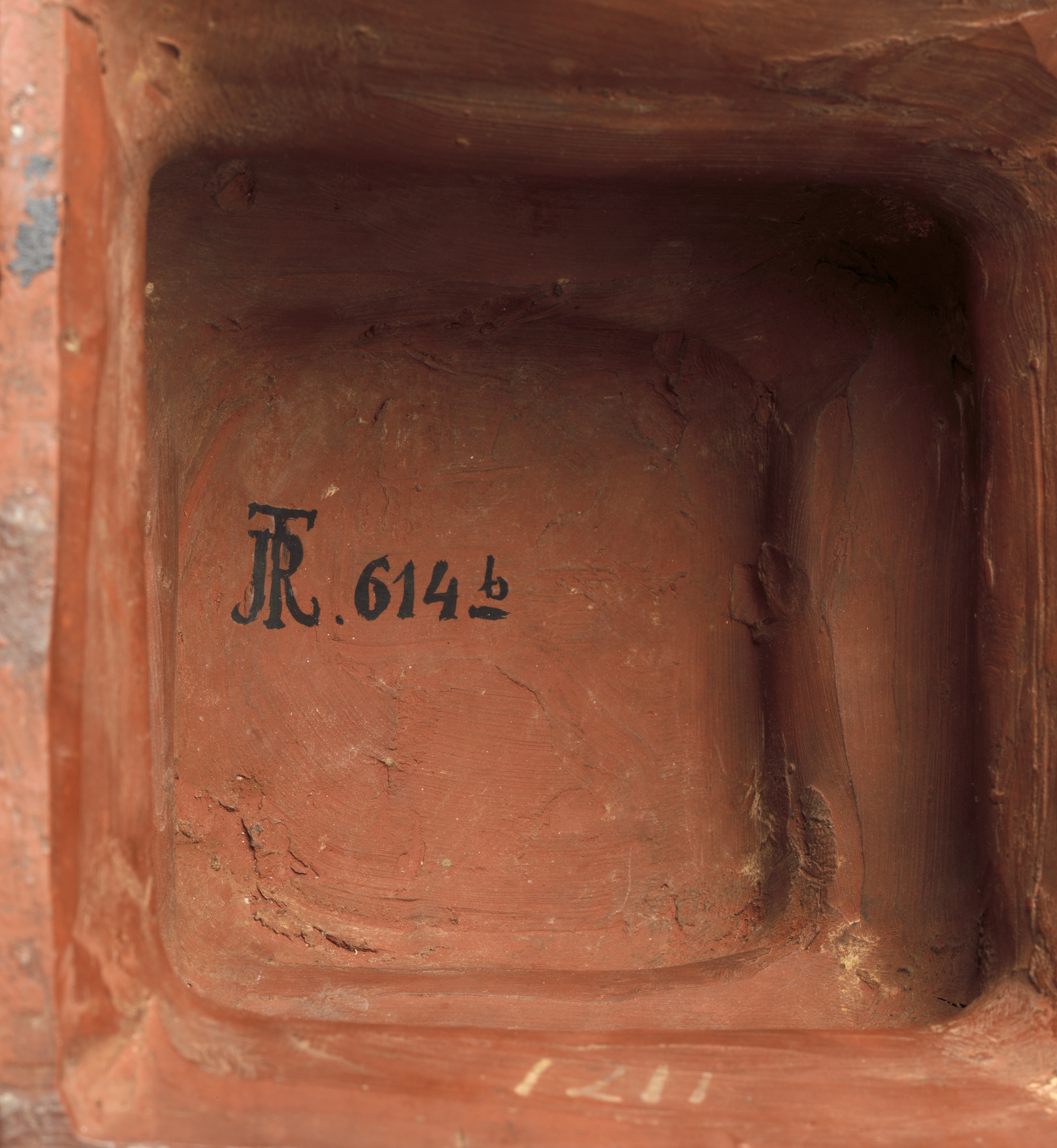Brighella on a pedestal
Manufactory Meissen Manufactory German
Factory director Böttger Period
Model attributed to Benjamin Thomae
The first product made at the Meissen factory in Germany was a dense red stoneware created during the factory’s inception from 1710 to 1713, after which the ability to manufacture porcelain was realized, and stoneware production was phased out. Most of the stoneware made at Meissen during these three years was in the form of wares, including numerous models of teapots, in particular,[1] as well as coffeepots,[2] tankards,[3] cups and saucers, tea caddies, and other useful objects. Large-scale, more ambitious objects, such as vases, were also made,[4] but the majority of works in red stoneware were functional rather than purely decorative.
At this same time a small quantity of sculpture was made in the form of low-relief plaques,[5] portrait heads,[6] and figures derived from Chinese deities (1974.356.319), but figures depicting European subjects were relatively rare. A small-scale figure of August II (1670–1733), commonly known as Augustus the Strong, elector of Saxony, king of Poland, is among the best known of these European figures,[7] and there is a male figure very much in the tradition of Baroque bozzetti, or preliminary models, that is notable for the freedom of its sculpting.[8] However, there are six figures in red stoneware depicting commedia dell’arte characters, which must rank as the most expressive and compositionally daring of Meissen’s production from this period. All six figures were acquired by Frederick II (1676–1732), Duke of Saxe-Gotha- Altenburg, prior to 1721, at which time they appear in the Friedenstein Castle inventories in Gotha,[9] where they remain today.[10] The figures now in the Friedenstein collections represent five of the male characters from the commedia dell’arte, including Brighella, Il Capitano, Harlequin, Pantalone, and Pulcinella; and one female character, Cantarina, who was a secondary figure in the troupe. The commedia dell’arte, often referred to as the Italian comedy, was a form of popular theater that originated in Italy during the late sixteenth century.[11] This form of comedic theater featured stock characters who embodied the range of human foibles, and its loosely drawn plots usually centered around themes of love, seduction, intrigue, vanity, greed, and miscommunication. The principal characters were identified by their costumes, as well as by the masks that several wore. Their personalities were well established and generally known to the audience, and the bawdy humor and spontaneity of the dialogue made the commedia dell’arte a highly popular theatrical form available to all classes of society.
By the mid-eighteenth century in Europe the commedia dell’arte was a popular source for modelers at porcelain factories throughout the Continent, and this genre was first fully explored at the Meissen factory beginning in the 1730s. In addition, the red-stoneware figures produced at Meissen are among the earliest, if not the very earliest, representations of commedia dell’arte characters in the medium of ceramics.[12] These figures are remarkably ambitious in terms of their modeling, and their dynamic poses skillfully express the theatrical nature of the subject matter (see 64.101.86). It is not known how many figures were produced, but based upon surviving examples, it appears that they were made in very small numbers.
The Brighella figure in the Museum’s collection is highly unusual with its polychrome decoration. Since the Meissen factory did not have the technical expertise to fire enamel colors until the early 1720s, the figure is decorated with “cold colors,” the term used to denote painted decoration that has not been fired. The matte quality of the polychromy is typical of unfired decoration, and these colors are often in a poor state of preservation. They have survived relatively well on the Museum’s figure, however, but slightly less successfully on the only other polychromed figure from this group known to the author, which is now in the Museum fur Angewandte Kunst, Frankfurt.[13] The traces of gilding on the Metropolitan’s figure, particularly along the edges of the robe and on the tasseled belt, indicate that its decoration was especially luxurious. All of the known Meissen red-stoneware commedia dell’arte figures are partially polished, including the two polychromed examples, resulting in a contrast of matte and glossy surfaces that lends a heightened degree of legibility and visual interest to the compositions.
The model represented by the Museum’s figure is customarily identified as a depiction of Brighella, who was one of the principal servant characters, known as zanni, in the Italian comedy. The example in Gotha has been published as Brighella in the most recent literature [14] however, it has been suggested by Clare Le Corbeiller that the Museum’s figure, and by extension the one in Gotha, may be an atypical representation of Pantalone instead.[15] The figure’s clothing, irrespective of coloring, does not correspond to the standard outfit worn by Brighella, but neither does it correspond to Pantalone’s typical attire,[16] which leaves its intended identity unresolved. Regardless, there is no doubt that the model depicts a commedia dell’arte figure, as indicated by its mask and its obviously theatrical pose.
The Museum’s figure stands on a red-stoneware pedestal that appears to be contemporary in date with the figure but probably not original to it. The stoneware body is consistent with Meissen’s production at this time, yet the integral base of the figure itself extends slightly beyond the top of the pedestal. None of the other red-stoneware commedia dell’arte figures are supported by similar pedestals, and it is not known if separate pedestals were produced at the time that the figures were made and are now lost, or if the figure and pedestal were united at some later date. The interior of the pedestal bears a painted mark that has not yet been interpreted but may someday shed light on its history.
Footnotes
(For key to shortened references see bibliography in Munger, European Porcelain in the Metropolitan Museum of Art. NY: The Metropolitan Museum of Art, 2018)
1 Eberle 2011b, pp. 56–62, nos. 31–48.
2 Ibid., pp. 49–56, nos. 18–28.
3 Meissen 1984, ill. nos. 77, 78; Blaauwen 2000, pp. 22–27, nos. 4–6.
4 See, for example, I. Menzhausen 1990, p. 196, pl. 23.
5 Meissen 1984, ill. nos. 152, 156, 157.
6 Ibid., ill. nos. 142–44, 147.
7 MMA 1982.60.318; Clare Le Corbeiller in Metropolitan Museum 1984a, pp. 250–51, no. 156.
8 Bursche 1980, pp. 56–57, no. 29.
9 Eberle 2011b, p. 29.
10 Ibid., pp. 39–45, nos. 2–7.
11 For a history of the commedia dell’arte, see Pietropaolo 2001.
12 At least two red-earthenware figures, one of which depicts Harlequin, were made in Delft in the years around 1700, and interestingly an example of Harlequin appears in a 1721 inventory of Augustus the Strong’s Japanese Palace, where his ceramic collection was displayed; Chilton 2001, p. 322, no. 139. It has been suggested that this figure may have inspired the modelers at Meissen to make the red-stoneware commedia dell’arte figures; Chilton 1998.
13 Meissen 1984, ill. no. 167.
14 I. Menzhausen 1993, p. 10; Jansen 2001, vol. 1, p. 37, no. 4; Eberle 2011b, pp. 40–41, no. 4.
15 Le Corbeiller 1990, p. 10.
16 For descriptions of costumes typically worn by Pantalone and Brighella, see Chilton 2001,
pp. 50–55, 90.
Due to rights restrictions, this image cannot be enlarged, viewed at full screen, or downloaded.
This artwork is meant to be viewed from right to left. Scroll left to view more.






